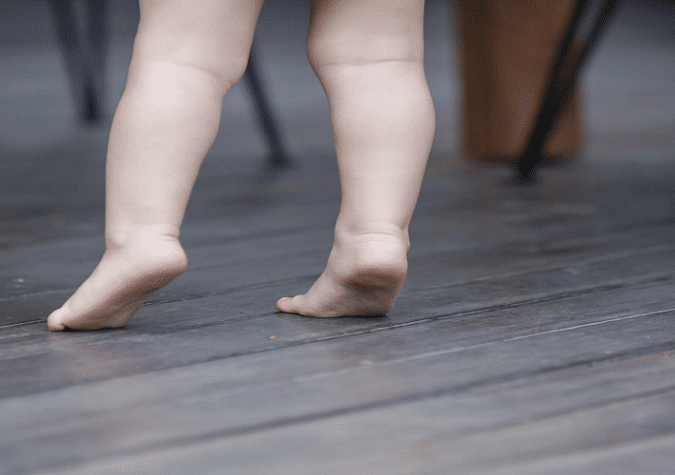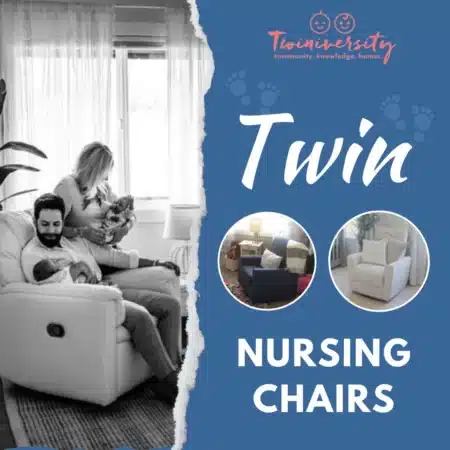Last updated on September 28th, 2021 at 01:27 pm
Have you noticed your child toe walking? See what a twin mom and pediatric physical therapist has to say about toe walking in children.
What is Toe Walking?
Toe walking in children can be defined as walking up on tip-toes without the heel hitting the ground; this is an atypical walking pattern. Toe walking is not always concerning. Most children will toe walk intermittently during their first 2 years as they experiment with balance reactions, sensory experiences, and different walking patterns. However, if your child is toe walking more than 50% of the time past 2 years of age, you should talk to your pediatrician and consider seeking the help of a physical and/or occupational therapist.
Did you know that Twiniversity has not one, but TWO podcasts that are FREE to download? Check them out today!
Why do Children Toe Walk?
A study published in the medical Journal of Pediatrics found that five to twelve percent of healthy children toe walk for no apparent reason at all. This is referred to as Idiopathic (meaning there’s no known cause) Toe Walking. You may also hear this being referred to as habitual toe walking. Idiopathic Toe Walking is the most common diagnosis associated with toe walking. It is more common in boys than girls and always involves both feet. There is also commonly a family history of toe walking.
Are you concerned about your 12-month-old twins’ meeting their milestones? We have put together a must-read first year with twins page that can answer all your twin questions!

A physical therapist, Lisa Persaud, says “Toe walking has become a huge problem in the past 12 years or so. We now have increased rates of autism, prematurity, and inactivity in children, and those three factors are contributing to the increasing rates.”
Get the Facts About Toe Walking
There are a number of other reasons a child may toe walk including sensory processing disorders, visual impairments, premature birth, muscle tone abnormalities such as cerebral palsy and Duchenne muscular dystrophy, and neurodevelopmental disorders, including autism. A study published in the medical journal Brain and Development found that 19 percent of children with Autism toe walk.
It is important to note that these possibilities are the expectation and not the rule. Rather, it is more likely than not that this is just a phase. Be patient, keep an eye on your little one(s), and guide them away from the toe walking when you see it. Before you know it, it will probably be a thing of the past.
Are you craving more from Twiniversity? Check out our awesome membership program and see what benefits you’re missing out on!

What is Wrong with Toe Walking?
Persistent toe walking can result in joint stiffness and muscle tightness, as well as muscle imbalance during a “prime time” of muscle development. It can also result in long term pain and development of abnormal movement patterns. Parents often report their children who toe walk have a hard time keeping up with their peers during the development of high-level gross motor skills – running, jumping, climbing, etc.
Toe walking can easily become a habit difficult to break. During the developmental years of ages 2-3, the brain is learning so much about movement patterns, balance reactions, and coordination. The structure of the foot is also very soft and flexible; much of that flexibility is lost by age 6. Toe walking that persists beyond these years can be difficult to change and can result in tendon stiffness. As you can imagine, tendon stiffness will make it even MORE difficult to break the habit of toe walking.
Are you planning to breastfeed your twins? Take our online breastfeeding twins class on-demand to get all your twin specific breastfeeding questions answered!

When to Seek Professional Help
- If your child is toe walking greater than 50% of the time
- When you notice your child is experiencing other gross motor difficulties including poor balance, decreased coordination, or muscle weakness
- If your child seems unable to keep up with their peers during higher-level activities including running, jumping, and climbing
- When your child is unable to stand or walk feet flat when told to do so
- If your child complains frequently of pain in the feet, ankles, knees, or hips
- If your child has very tight ankles or calf muscles
Are you expecting twins? Check out our Twiniversity expecting twins classes live or on-demand today!

Stay in the know by subscribing to our email list today! Be the first to hear about our giveaways and our favorite posts of the week!
What Can You Do to Discourage Toe Walking in Your Child?
- Stretch the ankle; make sure the knee is straight and flex the foot (toes toward the nose)
- Stand on an inclined wedge; this provides a stretch while giving good sensory input through the heels
- Stand on an uneven surface (i.e. a pillow, a couch cushion); in order to maintain balance, children typically rely on muscles that activate with feet flat
- Frog jumps (start in a deep squat and jump forward)
- Walk backward
- Walk up a slide (eek…I know this is often frowned upon at playgrounds but it’s a great activity!)
- Pick up marbles with toes; this strengthens the little muscles in the foot
- Walk forward with bean bags on top of feet; this reinforces a heel down position to keep the bean bag from falling off the foot
Better to be Safe Than Sorry
If you are seeing your child toe walking around the house, it should be of some comfort to know a Swedish study of more than 1,400 children says that more than half of all toe walking children stopped toe walking on their own before the age of 5.
If you are concerned about your child’s toe walking, consult your pediatrician or contact your local Early Intervention agency. Keep in mind that it is probably nothing to be worried about, but it certainly can’t hurt to have it checked out. And of course, the earlier toe walking can be addressed, the better for your child!
 Stacey Haught is a mom to 7-year-old Madison, 5-year-old twin boys – Mason and Mitchell, and 10-month-old twin girls – Sadie and Sophia. She is a pediatric physical therapist but has put her career on hold to stay at home with her rambunctious 5 kids. She resides with her husband and kids just outside of Pittsburgh, PA. Her family enjoys everything outdoors regardless of the season – gardening, finding new sledding hills, exploring area parks, and hiking and camping at their family cabin.
Stacey Haught is a mom to 7-year-old Madison, 5-year-old twin boys – Mason and Mitchell, and 10-month-old twin girls – Sadie and Sophia. She is a pediatric physical therapist but has put her career on hold to stay at home with her rambunctious 5 kids. She resides with her husband and kids just outside of Pittsburgh, PA. Her family enjoys everything outdoors regardless of the season – gardening, finding new sledding hills, exploring area parks, and hiking and camping at their family cabin.
References
Le Cras S, Bouck J, Brausch S. Evidence based clinical care guideline for management of idiopathic toe walking. Cincinnati Children’s Hospital Medical Center. 2011.
Sobel E, Caselli M, Velez z. Effect of persistent toe walking on ankle equinus. J Am Podiatr Med Assoc. 1997 Jan; 87(1):18-22.
https://orlafoley.com/wp-content/uploads/2016/06/AParentsGuidetoPediatricToeWalking.pdf







